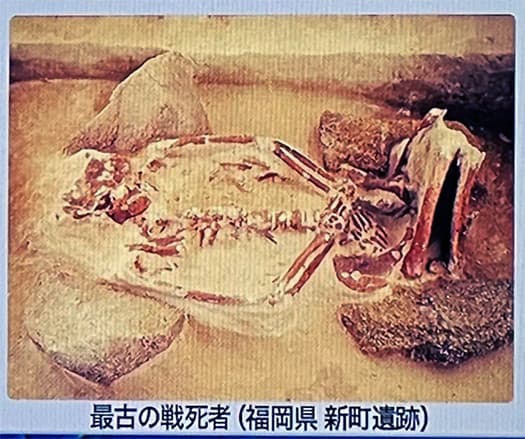



紀元前10世紀後半、約3,000年前九州北部で開始された農耕社会。
それとほぼ随伴して紀元前9世紀には「最初の戦死者」が出現する。
水田耕作は計画的に土地を土木工事して田んぼを造作し、
そこにこれも目的的に水利を確保するために「引水」することになる。
最初期から日本列島ではこういう計画的農耕が推進された。
したがって有利な土地を巡って、そして有利な「水利」を巡って
隣接するムラ集団同士は、恒常的な反目関係を生み出す。
縄文社会とは比較できないほどの「人口密度」社会では
こういった緊張関係が加速度的に進展したことは理の当然。
いちばん上の発掘写真は開始された列島社会での戦争の死者の埋葬例。
人類社会普遍の進化として戦争行為というものはある。
食糧の大量生産とその富の蓄積は、同時にそれを略奪しようとする
人類普遍的な欲望を強く刺激した。
生産基盤となる「農業土木」は大量の人員の労働力によって成立するので、
縄文とは比較にならない人口規模社会であり、その土木技術と成員拡大で
戦争の手段と人員「知恵と工夫」も進化したと言えるのだろう。
そのような事態の進展に対応して広域に「環濠」集落が成立する。
ムラ社会は日常の生産活動の集団化によって集村化が自然で
生活共同体としてのムラが発生した。日常生活の竪穴住居群や
生産物を保存する高床倉庫などがそのなかで構築された。
そういうムラ集住環境では、外敵からの襲撃に備えて
共同体の土地の周囲を環濠で囲むようにして、さらにそこで掘られた土を
土塁として高く盛り上げた。頂部にはさらに木組みの柵が構築された。
さらにその周囲には逆茂木や乱杭を設置。初源の「城」だろう。
防衛的戦争準備とするようになっていった。
弥生の初期600年間では金属器・鉄器はまだ普及せず、
人びとは生産作業道具としては木製の鍬やスキなど、そしてコメの採取でも
「石包丁」で収穫していたとされている。
ただ、縄文以来の狩猟具としての弓矢などは当然保持して
戦いの主要武器になっただろうし、石棒から進化した石刀もあった。
後半の600年間以降は開発導入された青銅器・鉄器といった、より鋭利な武器に
進化して行くけれどこの前期段階でもすでに「戦死者」が出ている。
マルクスエンゲルスが想像したような古代社会のありようではなく、
こういう初源的な戦争においても参加者は主体的意思を持っていたと思える。
ムラを守る、という集団的自衛権・自然的な発意からだろう。
いずれにしてもこのような「戦争の起源の発掘」のようなことも
考古事実・人類知として客観的把握できるようになってきたことは
非常に素晴らしいと思う次第。
戦争という人類が随伴した惨禍についても冷静にそれを評価判断することで
それをどう克服できるのかということに繋がっていくだろう。
English version⬇
Agrarian Society and War Simultaneously: The 37,000-Year History of the Japanese Archipelago - 27
The development of agricultural engineering, water use, land conflicts, and other aspects of agriculture were always accompanied by the danger of war. Moat encircling settlements for collective self-defense appeared at the same time. War, war, and war
Late 10th century B.C., about 3,000 years ago, an agrarian society began in northern Kyushu.
agricultural society that began in northern Kyushu about 3,000 years ago in the late 10th century B.C. The "first war dead" appeared in the 9th century B.C.E., almost as a corollary.
Paddy field cultivation was a method of systematically constructing rice paddies by civil engineering.
This was also done for the purpose of "drawing water" in order to secure water supply.
From the beginning, this type of planned agriculture was promoted in the Japanese archipelago.
Therefore, neighboring village groups were competing with each other for favorable lands and for favorable "water resources".
Adjacent village groups would develop a constant rivalry with each other.
In a "densely populated" society that cannot be compared to Jomon society
It is only natural that these tensions developed at an accelerated pace.
The top photo is an example of the burial of war dead in an archipelagic society initiated in this way.
The act of war is a universal evolution of human society.
The mass production of food and the accumulation of its wealth have at the same time
The mass production of food and the accumulation of its wealth have at the same time strongly stimulated the universal desire of humankind to plunder it.
The "agricultural engineering" that forms the basis of this process is based on the labor of large numbers of people, so the scale of the population is not comparable to that of the Jomon.
The Jomon were a society with a population scale incomparable to that of the Jomon, and with their civil engineering technology and expansion of their members, they were able to
The means of warfare and "wisdom and ingenuity" also evolved with the expansion of civil engineering technology and the number of members.
In response to this development, "moat encircling" settlements were established over a wide area.
Mura society is a natural result of the collectivization of daily production activities, and the emergence of the mura as a community of life.
The mura emerged as a living community. Pit dwellings for daily life and stilted warehouses for storing products were built.
and warehouses on stilts for storing products were constructed.
In such a village environment, the community land was surrounded by a ring
The earth dug up from the moat was raised high as an earthwork.
The earth dug up there was heaped up high as an earthen mound. At the top, a wooden fence was further constructed.
In addition, reverse bushes and random stakes were set up around it.
These were used as defensive preparations for war.
In the first 600 years of the Yayoi period, metal and iron tools were not yet widely used.
People used wooden hoes and skis as tools for production work, and even for rice harvesting
It is believed that people used wooden hoes and skis as tools for production, and stone knives for rice harvesting.
However, they naturally retained bows and arrows, which had been used as hunting tools since the Jomon period, and which were probably the main weapons in battle.
The stone sword was also introduced as an evolution from the stone stick.
In the latter half of the 600 years, the weapons evolved into sharper weapons such as bronzes and irons, which were developed and introduced during this period.
Even in this early stage, however, there were already "deaths in battle.
This is not the way Marx Engels imagined ancient societies to be, but the way they were in the beginning.
Even in these primordial wars, the participants seem to have had a proactive will.
It may be out of a collective self-defense or natural initiative to protect the mullahs.
In any case, this kind of "excavation of the origins of war" is also
I think it is wonderful that we are now able to objectively grasp human knowledge
I think it is wonderful that we can now objectively grasp human knowledge as archaeological facts.
By calmly evaluating and judging the scourge of war that has accompanied mankind, we can connect to the question of how we can overcome it.
how we can overcome them.



















